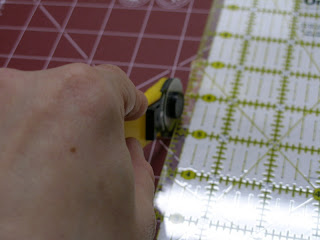Today I thought I'd share a picture of first quilting project. I made this about thirteen years ago and although it is full of mistakes, I proudly display it to remind me of what I can accomplish without boundaries.
I'm completely self-taught, getting the majority of my quilting knowledge from books or articles I've read, quilting programs on TV, other quilter's who so generously share their knowledge and experience, and from my own experiences... or lessons learned as I like to refer to it.
I'm completely self-taught, getting the majority of my quilting knowledge from books or articles I've read, quilting programs on TV, other quilter's who so generously share their knowledge and experience, and from my own experiences... or lessons learned as I like to refer to it.

I had purchased a set of Kaye Woods' Starmaker templates and began to 'practice' making cuts with one of them. My first project is the result of my practicing.
Back then I knew nothing about squaring up blocks or measuring from the center for the length and width of the border before cutting my strips. I wasn't even concerned about matching points yet. I'm sure I managed to match one or two, but when I look at it hanging up on my wall, I don't see whether the points are matching or whether it lies flat. What I see is the results of someone's creative expression, all done without boundaries.
Sometimes I think we set ourselves up to fail if we always follow the rules. And perhaps these rules are important when it comes to critical areas such as getting your project to lie flat, but in other areas I think they’re meant to be broken; or at least bent a little.
So the next time you’re selecting fabric for your next project and you just love those orange and lime green prints with a splash of purple, use them to your heart’s content. Let your boundaries down and cut away. And above all, have fun doing it!

Back then I knew nothing about squaring up blocks or measuring from the center for the length and width of the border before cutting my strips. I wasn't even concerned about matching points yet. I'm sure I managed to match one or two, but when I look at it hanging up on my wall, I don't see whether the points are matching or whether it lies flat. What I see is the results of someone's creative expression, all done without boundaries.
Sometimes I think we set ourselves up to fail if we always follow the rules. And perhaps these rules are important when it comes to critical areas such as getting your project to lie flat, but in other areas I think they’re meant to be broken; or at least bent a little.
So the next time you’re selecting fabric for your next project and you just love those orange and lime green prints with a splash of purple, use them to your heart’s content. Let your boundaries down and cut away. And above all, have fun doing it!






















































































































